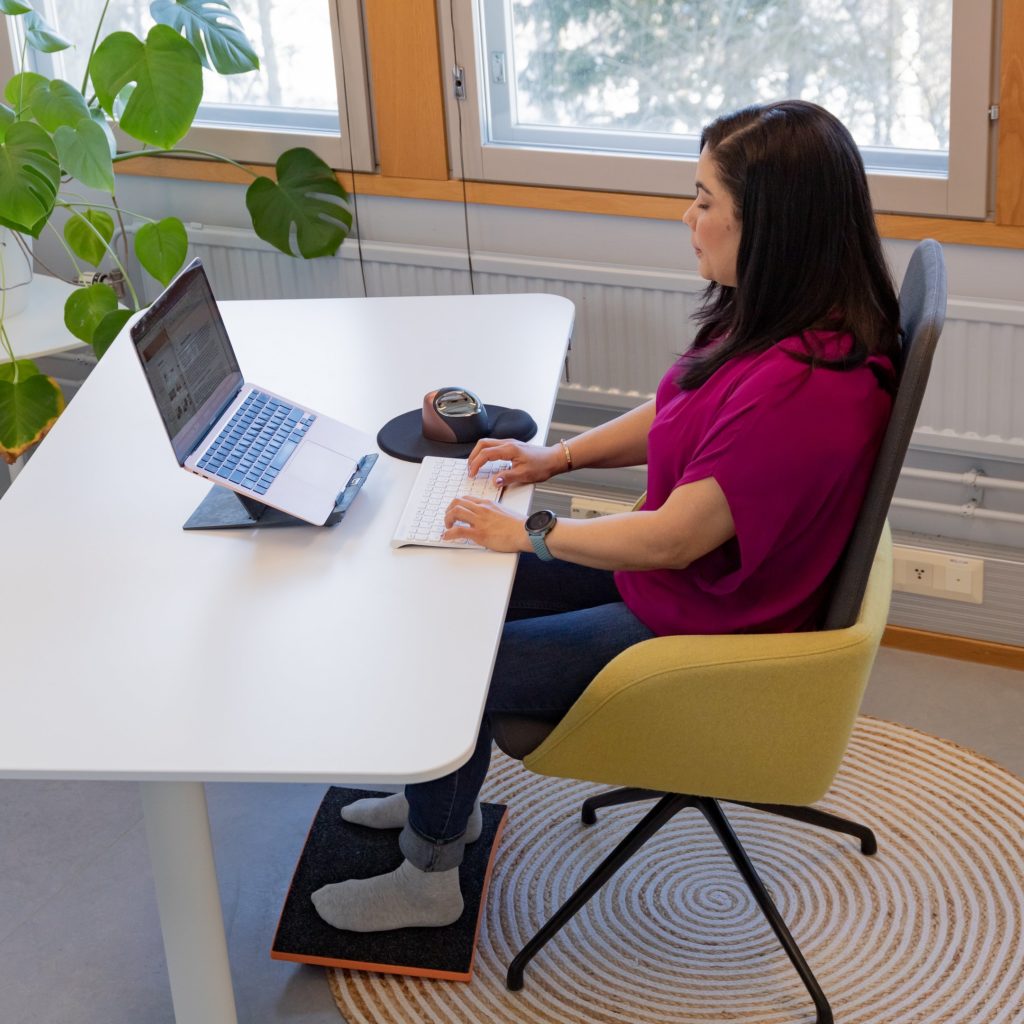A laptop stand prevents neck strain by elevating your screen to eye level, allowing you to maintain a neutral neck position while working. This ergonomic adjustment eliminates the need to look downward at your screen, which typically forces your neck into an unnatural forward-bent position. By bringing the display closer to eye height, laptop stands help maintain natural spine curve, reduce muscle tension in your neck and shoulders, and promote better overall posture during extended computer use.
Understanding neck strain from improper laptop use
When you work on a laptop placed flat on a desk, you’re forced to tilt your head downward for hours, creating what experts call “tech neck”. This position puts significant stress on your cervical spine and surrounding muscles.
The human head weighs approximately 4.5-5.5 kg, and when tilted forward, this weight multiplies the pressure on your neck. Research shows that even a 15-degree forward tilt can increase the effective weight on your neck to about 12 kg, while a 60-degree tilt (common when looking down at a laptop) can increase it to a staggering 27 kg.
This biomechanical strain affects not only your neck but also radiates to your shoulders, upper back, and even causes headaches. The standard laptop design creates this ergonomic challenge because the screen and keyboard are attached, forcing you to compromise either neck or wrist positioning.
For students, this issue is particularly concerning. Poor posture in the classroom or during study sessions can significantly impact student focus and learning retention, as physical discomfort diverts attention away from educational content.
How does a laptop stand improve neck positioning?
A laptop stand directly addresses neck strain by elevating your screen to eye level, creating a neutral neck alignment. This positioning allows you to maintain the natural curve of your cervical spine while viewing your screen.
The optimal viewing angle places the top of your screen at or slightly below eye level, approximately 50-70 cm from your face. This position prevents both looking up (which strains the back of your neck) and looking down (which strains the front of your neck and shoulders).
By adjusting the height of your laptop, a stand helps you maintain what ergonomists call the “neutral position” – where your head sits balanced atop your spine without forward tilting. This position requires minimal muscle effort to maintain, reducing fatigue and strain throughout your workday.
For students, proper neck positioning contributes significantly to improved posture in the classroom and sustained focus during lectures or study sessions. When physical discomfort is eliminated, cognitive resources can be fully dedicated to learning rather than managing pain.
What features should you look for in an ergonomic laptop stand?
The most important feature in a laptop stand is height adjustability, which allows you to position your screen precisely at eye level regardless of your sitting or standing height. This customisation ensures optimal neck positioning for your specific body proportions.
Other essential features to consider include:
- Stability: Your stand should hold your laptop securely without wobbling, particularly important when typing
- Portability: If you work in multiple locations, a lightweight, foldable stand enables consistent ergonomics everywhere
- Compatibility: Ensure the stand accommodates your laptop size and weight properly
- Ventilation: Adequate airflow prevents overheating, extending your laptop’s lifespan
- Angle adjustability: Some stands offer tilt options to reduce glare and improve screen visibility
For educational environments, portable stands that can be easily moved between classrooms support consistent posture for both teachers and students, enhancing student focus through physical comfort.
Can a laptop stand be part of a complete ergonomic workspace?
A laptop stand is indeed a fundamental component of a comprehensive ergonomic workspace, but it works best when combined with other ergonomic equipment. The ideal setup includes an external keyboard and mouse positioned at elbow height to maintain proper wrist alignment.
This complete workspace solution addresses the inherent design limitation of laptops – when the screen is at eye level, the attached keyboard becomes too high for proper wrist positioning. By separating these elements, you can optimise both neck and wrist ergonomics simultaneously.
Additional elements of a complete ergonomic workspace include:
- An adjustable chair with proper lumbar support
- A height-adjustable desk for sitting and standing that allows alternating between sitting and standing
- Proper lighting to reduce eye strain and associated neck tension
- Regular movement breaks to prevent static posture
For educational institutions, creating ergonomic study environments that incorporate laptop stands can significantly improve student focus and comfort during long study sessions, leading to better learning outcomes.
Key takeaways for preventing neck strain while working
Preventing neck strain requires a holistic approach that combines proper equipment with healthy work habits. While a laptop stand provides the foundation for proper neck alignment, remember these additional practices:
- Position your screen at eye level with the top of the monitor at or slightly below eye height
- Maintain an arm’s length distance (about 50-70 cm) between your eyes and screen
- Take regular breaks using the 20-20-20 rule: every 20 minutes, look at something 20 feet away for 20 seconds
- Perform gentle neck stretches throughout your workday
- Strengthen muscles with ergonomic balance boards to better support proper posture
For students, applying these principles improves posture in the classroom and supports better focus during lectures and study sessions.
We offer ergonomic solutions like our adjustable laptop stand that complements these practices, helping you maintain proper posture throughout your workday. By investing in proper ergonomics now, you can prevent the cumulative damage that leads to chronic neck pain and maintain productivity and comfort for years to come.

